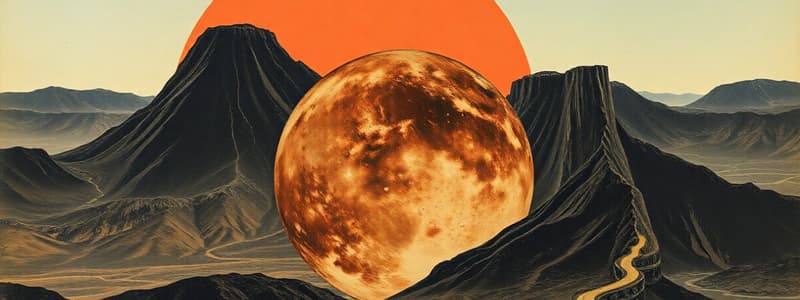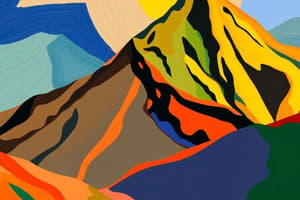Podcast
Questions and Answers
How did the formation of the Hawaiian Islands primarily differ from the formation of the Rocky Mountains, according to the passage?
How did the formation of the Hawaiian Islands primarily differ from the formation of the Rocky Mountains, according to the passage?
- The Hawaiian Islands are no longer changing, while the Rocky Mountains continue to grow.
- The Hawaiian Islands were formed above sea level, whereas the Rocky Mountains were formed underwater.
- The Hawaiian Islands were formed by weathering, whereas the Rocky Mountains were formed by deposition.
- The Hawaiian Islands were formed by volcanic activity, whereas the Rocky Mountains were formed by the movement of tectonic plates. (correct)
What evidence does the passage provide to support the claim that landforms are constantly changing?
What evidence does the passage provide to support the claim that landforms are constantly changing?
- The guide book's description of Colorado's history.
- The ongoing volcanic activity in Hawaii and the weathering of tombstones in Cape Cod. (correct)
- The tour guide's smug demeanor.
- The rapid construction of modern buildings demonstrates the ability to alter landscapes quickly.
Which process best describes how mosses contribute to the weathering of landforms, as exemplified by the Appalachian Mountains?
Which process best describes how mosses contribute to the weathering of landforms, as exemplified by the Appalachian Mountains?
- Mosses extract minerals from the rocks, weakening their structure over an extended period.
- Mosses cause the landforms to sink over time due to their weight.
- Mosses physically break down rocks by expanding and contracting with moisture changes.
- Mosses secrete acids that chemically dissolve the rock material. (correct)
The tour guide argued that if landform changes are not visible, they cannot be proven. What concept from the text contradicts this?
The tour guide argued that if landform changes are not visible, they cannot be proven. What concept from the text contradicts this?
How does the mention of acid rain contribute to the explanation of the Appalachian Mountains' reduction in height?
How does the mention of acid rain contribute to the explanation of the Appalachian Mountains' reduction in height?
Flashcards
Formation of Hawaiian Islands
Formation of Hawaiian Islands
The Hawaiian Islands were formed by underwater volcanoes that erupted, cooled, and formed rock.
Dynamic Landforms
Dynamic Landforms
Landforms are perpetually changing through various processes.
Weathering
Weathering
The physical, chemical, or biological breakdown of landforms.
Appalachian Weathering
Appalachian Weathering
Signup and view all the flashcards
Deposition
Deposition
Signup and view all the flashcards
Study Notes
- Landforms are continuously changing worldwide.
Volcanoes
- The Hawaiian Islands were formed from underwater volcanoes.
- With each eruption, cooled lava formed rock, increasing the volcano's height.
- This process caused the volcanoes to emerge from the water, forming islands.
- The Hawaiian Islands are still growing, and a new island is expected to form to the west in a few thousand years.
- The Rocky Mountains were formed by the movement of tectonic plates.
Weathering
- Weathering involves physical, chemical, or biological processes that break down landforms.
- Examples of weathering can be observed on tombstones in cemeteries, where moss and organisms erode the stone.
- The Appalachian Mountains were once as tall as the Rockies but have been reduced in height due to weathering.
- Factors contributing to the weathering of the Appalachians include mosses, acid rain, and temperature fluctuations.
Deposition
- Deposition is the process of adding sediments and rocks to a landform.
- Beaches are re-deposited every year through deposition.
- The Canadian Shield was formed by the deposition of glaciers thousands of years ago.
- Glacial deposition has made the land in the Canadian Shield more fertile.
Studying That Suits You
Use AI to generate personalized quizzes and flashcards to suit your learning preferences.





